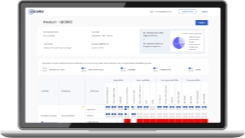
The Head of Business Development plays a crucial role in driving a company's growth by identifying new opportunities, building strategic partnerships, and expanding market reach. This leadership position requires strong analytical skills, industry knowledge, and the ability to negotiate high-value deals that align with the company’s long-term vision.
The Head of Business Development ensures sustainable revenue growth and competitive advantage by fostering relationships with key stakeholders and leveraging market trends.
Beyond identifying new business avenues, this role also involves overseeing sales strategies, managing cross-functional teams, and setting clear objectives to achieve corporate goals.
The Head of Business Development collaborates with marketing, finance, and product teams to create innovative solutions that meet customer needs and maximize profitability. In this article, you will discover the roles and responsibilities of the Head of Business Development.
What Does a Head of Business Development Do?
A Head of Business Development drives a company's growth by identifying new market opportunities, forming strategic partnerships, and expanding revenue streams. They conduct in-depth market research to analyze industry trends, customer needs, and competitor activities to develop effective business strategies. By leveraging strong leadership and negotiation skills, they secure high-value deals that align with the company's long-term vision.
They also oversee sales strategies, ensure alignment with marketing efforts, and collaborate with various departments to optimize business performance. They set clear revenue targets, manage cross-functional teams, and implement initiatives that enhance brand positioning. Their role also involves monitoring key performance indicators (KPIs) and adjusting strategies based on market dynamics to ensure sustained business success.
Effective business development leadership extends beyond sales, encompassing risk management, innovation, and relationship-building with key stakeholders. The Head of Business Development must stay ahead of industry shifts, regulatory changes, and technological advancements to maintain a competitive edge by fostering strong client relationships and developing scalable business models.
According to Zippia, the job market for Heads of Business Development is expected to grow by 10% from 2018 to 2028, highlighting the increasing demand for strategic growth leaders. Over the next decade, approximately 33,700 new positions are projected, offering significant career opportunities in various industries. Currently, more than 28,475 professionals hold this role in the United States, reflecting its importance in driving business expansion and market success.
5 Crucial Roles & Responsibilities of Head of Business Development
.webp)
1. Driving Strategic Growth and Market Expansion
A Head of Business Development is responsible for identifying new market opportunities and creating strategies to expand. They analyze industry trends, emerging markets, and competitive insights to craft innovative growth plans that drive long-term success. By leveraging data-driven decision-making and strategic partnerships, they ensure sustainable revenue growth.
They continuously refine business strategies to align with shifting consumer demands and global economic trends. This involves collaborating with key stakeholders, investors, and internal teams to develop scalable business models. Their proactive approach helps companies stay ahead of the competition while fostering a culture of innovation and adaptability.
2. Building and Nurturing Strategic Partnerships
Establishing strong relationships with industry leaders, suppliers, and clients is a core responsibility of the Head of Business Development. Strategic collaborations play a crucial role in expanding networks, gaining market access, and enhancing brand credibility. By negotiating high-value deals and fostering long-term partnerships, they drive business growth and create new revenue streams.
Beyond forming partnerships, they must nurture these relationships through continuous engagement, trust-building, and value-driven collaboration. It includes aligning business objectives with partners' goals to ensure mutual success and sustainable innovation. Their ability to maintain strong professional networks positions the company as a trusted leader.
3. Overseeing Sales and Revenue Growth Strategies
A key responsibility of the Head of Business Development is to oversee sales strategies that maximize revenue potential. By developing data-backed sales initiatives, they help teams identify high-value prospects and streamline conversion processes. Their expertise in sales forecasting, pricing models, and customer engagement ensures the company meets and exceeds its revenue goals.
They implement performance metrics and key performance indicators (KPIs) to track sales effectiveness and optimize strategies in real-time. By working closely with sales and marketing teams, they align messaging, product positioning, and outreach efforts for maximum impact. Their leadership ensures revenue growth in an increasingly competitive business environment.
4. Leading Innovation and Digital Transformation
As businesses embrace digital transformation, the Head of Business Development plays a pivotal role in integrating innovative technologies. They identify digital tools, automation solutions, and AI-driven insights that enhance operational efficiency and customer experience. By championing technology adoption, they help businesses stay competitive.
Beyond technology integration, they drive innovation by fostering a culture of creativity and adaptability within the organization. This involves encouraging teams to explore emerging business models, invest in cutting-edge solutions, and develop future-ready strategies. Their ability to embrace change ensures long-term success in a rapidly evolving marketplace.
5. Foster Sustainable & ESG-Focused Growth
The Head of Business Development (HBD) plays a crucial role in driving sustainable and ESG-focused growth by aligning business expansion strategies with environmental, social, and governance (ESG) principles. They identify growth opportunities that not only generate revenue but also meet global sustainability standards, ensuring long-term value creation.
By integrating ESG considerations into partnerships and investments, the HBD helps the company enhance its reputation, attract ethical investors, and build trust with socially conscious consumers.
Leveraging technology and innovation, HBD implements data-driven ESG strategies that optimize operations while reducing environmental impact. They collaborate with key stakeholders to adopt sustainable supply chains, carbon-neutral initiatives, and ethical business practices that future-proof the company.
By championing responsible business growth, HBD ensures compliance with evolving regulations and strengthens the company’s position as a leader in sustainable innovation.
Head of Business Development Salaries in Different Countries
1. United States: A Head of Business Development typically earns a total annual compensation of around $327,821. The remaining $171,542 comes from additional pay, such as bonuses, commissions, and other financial incentives.
2. United Kingdom: The Head of Business Development can earn an estimated annual salary of around £96,986. On average, professionals in this role receive a base salary of approximately £74,211 per year.
3. India: The annual salary for a Business Development Head in India typically falls between ₹5.4 Lakhs and ₹50.0 Lakhs. This range is based on insights gathered from 4,300 recently reported salaries across multiple industries.
4.Australia: A Head of Business Development can expect to earn an annual compensation of approximately $190,000, with an average base salary of around $150,000 annually.
Qualifications and Skills Required for a Head of Business Development
To excel as a Head of Business Development, professionals must possess a strong educational foundation, extensive experience in business growth strategies, and a well-rounded skill set.
- Educational Background: A bachelor’s degree in Business Administration, Marketing, Finance, or a related field is typically required. Many organizations prefer candidates with a Master of Business Administration (MBA) or other advanced qualifications to ensure a deep understanding of strategic growth and financial management.
- Professional Experience: Extensive experience in business development, sales leadership, and strategic partnerships is essential. Candidates should have a proven track record in expanding market reach, securing high-value deals, and driving revenue growth. Experience in cross-industry collaboration, contract negotiation, and business forecasting is highly valued.
- Strategic Growth Planning: A Head of Business Development must develop and implement long-term growth strategies that align with corporate objectives. This includes identifying new market opportunities, fostering innovation, and ensuring sustainable business expansion. Effective planning ensures competitive positioning in a rapidly evolving industry landscape.
- Sales and Revenue Optimization: Driving sales performance and increasing revenue streams are critical responsibilities. Business development leaders must craft effective sales strategies, optimize lead conversion processes, and collaborate with marketing teams to enhance customer acquisition. Data-driven decision-making plays a vital role in maximizing profitability.
- Partnership and Relationship Management: Building and maintaining strong relationships with key stakeholders, clients, and business partners is crucial for long-term success. The ability to establish trust, negotiate mutually beneficial agreements, and foster strategic alliances strengthens the company’s market position. Networking and collaboration drive business expansion and innovation.
- Market Intelligence and Competitive Analysis: Understanding industry trends, customer behaviors, and competitive strategies is vital. Heads of Business Development must conduct thorough market research, assess emerging trends, and leverage data analytics to inform decision-making. A well-informed approach helps businesses stay ahead of competitors and capitalize on new opportunities.
Certifications to Enhance Competitiveness as a Head of Business Development in 2025
Obtaining industry-recognized certifications can enhance credibility and demonstrate expertise in business growth strategies.
- Certified Business Development Professional (CBDP): Validates expertise in lead generation, sales strategy, and market expansion techniques.
- Strategic Management Certification: Strengthens skills in corporate strategy development, risk assessment, and competitive positioning.
- Negotiation and Conflict Resolution Certification: Equips professionals with advanced negotiation techniques to secure high-value deals and partnerships.
- Data Analytics for Business Leaders: Enhances the ability to interpret market trends, customer insights, and financial data for informed decision-making.
- Digital Marketing Leadership Certification: Provides expertise in leveraging digital platforms for business expansion and lead generation.
Day-to-Day Activities and Deliverables of a Head of Business Development
A Head of Business Development oversees various tasks to drive business growth, secure new opportunities, and optimize market positioning.
- Identifying and pursuing new business opportunities to increase revenue streams.
- Developing and executing strategic sales plans to enhance market presence.
- Engaging in high-level negotiations with clients, partners, and stakeholders.
- Collaborating with marketing teams to optimize lead generation and brand visibility.
- Monitoring industry trends, competitor movements, and customer demands.
- Managing and mentoring business development teams to achieve organizational goals.
- Presenting growth reports, financial forecasts, and expansion strategies to executives.
Key Departments a Head of Business Development Closely Works With
To drive growth, the Head of Business Development collaborates with key internal teams. Here are the key departments of Head of Business Development:
1. Sales Department: Close coordination with the sales team ensures seamless execution of business strategies, lead conversions, and revenue optimization. Aligning sales targets with broader business objectives enhances overall performance.
2. Marketing Department: Marketing teams provide essential market insights, customer data, and branding strategies that drive business expansion. Collaboration ensures lead-generation efforts.
3. Finance Department: Financial planning, budgeting, and revenue forecasting are critical aspects of business growth. Working closely with the finance team ensures profitability and effective resource allocation.
4. Operations Department: Operational efficiency directly impacts service delivery and scalability. Business development leaders collaborate with operations teams to ensure the smooth execution of growth initiatives.
5. Legal and Compliance Department: Business development often involves contractual agreements, regulatory requirements, and compliance policies. Partnering with legal experts ensures all deals are legally sound and risk-free.
Roadmap to Becoming a Head of Business Development
The journey to becoming a Head of Business Development follows a structured path, requiring experience, strategic skills, and industry expertise.
1. Educational Foundation: Obtain a bachelor’s degree in Business, Marketing, or a related field. Consider an MBA or professional certification to strengthen your leadership skills.
2. Entry-Level Experience: Start in sales, marketing, or business analysis roles to build foundational skills in client relations, market research, and strategic planning.
3. Mid-Level Management: Advance to managerial positions such as Sales Manager, Business Development Manager, or Strategic Partnership Lead. Gain experience in negotiation, deal structuring, and revenue growth strategies.
4. Senior Leadership Roles: Transition into executive positions, such as Director of Business Development or VP of Sales. Develop high-level strategic planning skills and oversee large-scale market expansion efforts.
5. Achieve the Head of Business Development Role: Secure the position by demonstrating leadership, industry expertise, and a proven ability to drive business growth. Stay updated with industry trends and continue professional development through leadership programs.
Conclusion
The Head of Business Development plays a pivotal role in shaping a company’s growth strategy through market expansion, strategic partnerships, and revenue-driven initiatives. Their ability to analyze industry trends, develop scalable business models, and foster key relationships ensures long-term success in a competitive marketplace.
By leading sales strategies, innovation, and digital transformation, they drive sustainable growth while adapting to evolving business landscapes. Effective risk management and compliance oversight further enhance operational stability, protecting the company from market uncertainties. As demand for skilled business development leaders continues to rise, professionals in this role must embrace continuous learning and strategic adaptability.
By partnering with Edstellar, you're not only preparing your top talent for business development roles but also empowering your HR team with the powerful Skill Matrix tool. This innovative solution provides a clear, data-driven understanding of skill levels across your organization, allowing for targeted development and smarter workforce planning.
With Edstellar's expertise and tools, you're setting your team up for success, ensuring they’re equipped with the skills and insights needed to drive growth and innovation in the future.
Explore High-impact instructor-led training for your teams.
#On-site #Virtual #GroupTraining #Customized
Edstellar Training Catalog
Explore 2000+ industry ready instructor-led training programs.

Coaching that Unlocks Potential
Create dynamic leaders and cohesive teams. Learn more now!


Want to evaluate your team’s skill gaps?
Do a quick Skill gap analysis with Edstellar’s Free Skill Matrix tool

Stay informed on L&D best practices
Get periodic updates on learning and development industry trends, expert insights, success stories and innovative training practices from Edstellar.
.svg)
Featured Post
.webp)
Contact Us
Submit your Training Requirements below and We'll get in touch with you shortly.
.svg)



.svg)


.svg)

.svg)
.svg)
.svg)

